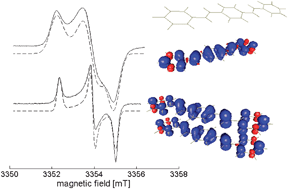The solid-state organization of ‘self-doped’ PPV oligomers†
Abstract
Using a combination of multi-frequency

* Corresponding authors
a
University of Antwerp, Department of Physics, Universiteitsplein 1, B-2610 Antwerp, Wilrijk, Belgium
E-mail:
sabine.vandoorslaer@ua.ac.be
Fax: +32 3 265 2470
Tel: +32 3 265 2461
b
University of Antwerp, Department of Chemistry, Universiteitsplein 1, B-2610 Antwerp, Wilrijk, Belgium
E-mail:
frank.blockhuys@ua.ac.be
Fax: +32 3 265 2310
Tel: +32 3 265 2365
c
High Resolution NMR Centre, Department of Materials and Chemistry (MACH), Vrije Universiteit Brussel, Pleinlaan 2, B-1050 Brussels, Belgium
E-mail:
rwillem@vub.ac.be
Fax: +32 2 629 3281
Tel: +32 2 629 3282
Using a combination of multi-frequency

 Please wait while we load your content...
Something went wrong. Try again?
Please wait while we load your content...
Something went wrong. Try again?
Y. Ling, P. Kozakiewicz, F. Blockhuys, M. Biesemans, C. Van Alsenoy, H. Moons, E. Goovaerts, R. Willem and S. Van Doorslaer, Phys. Chem. Chem. Phys., 2011, 13, 18516 DOI: 10.1039/C1CP21786K
To request permission to reproduce material from this article, please go to the Copyright Clearance Center request page.
If you are an author contributing to an RSC publication, you do not need to request permission provided correct acknowledgement is given.
If you are the author of this article, you do not need to request permission to reproduce figures and diagrams provided correct acknowledgement is given. If you want to reproduce the whole article in a third-party publication (excluding your thesis/dissertation for which permission is not required) please go to the Copyright Clearance Center request page.
Read more about how to correctly acknowledge RSC content.
 Fetching data from CrossRef.
Fetching data from CrossRef.
This may take some time to load.
Loading related content
